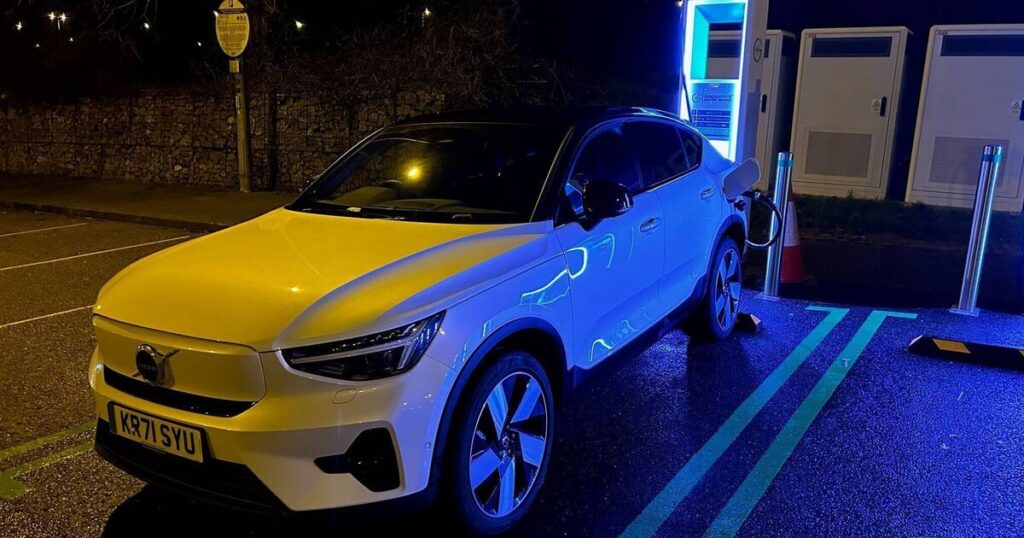

The impressive – but expensive – super-fast charger at Exeter (Image: Steve Smith)
Something like 13 years ago, I was given the opportunity to take a Nissan Leaf for a test drive over several days. It was the trailblazer for mainstream electric vehicles in the UK.
Prior to the Leaf’s arrival, we had only seen a handful of quirky city cars produced in limited quantities, but it was the Leaf that truly ignited our transition to electric vehicles. However, these were still early days and despite the Leaf’s groundbreaking status, the initial model could barely manage 100 miles before requiring a recharge.
Moreover, public charging facilities were few and far between, and rather slow, rendering the car primarily suitable for local journeys followed by overnight charging at home.
Fast forward to the present day and the landscape has undergone a dramatic transformation. After Tesla made its debut in the UK market, I had the chance to drive its Model S in 2015, which marked a significant advancement with its extended range, positioning it as a viable alternative to petrol and diesel vehicles.
Nowadays, nearly every car manufacturer boasts an all-electric model and, crucially, the charging infrastructure is vastly superior compared to when I first drove the Leaf, with charging points now widely available. Over the years, I’ve also taken several other electric vehicles out for a test drive.
However, I never felt entirely comfortable embarking on long journeys due to the fear of running out of charge – a phenomenon commonly referred to as ‘range anxiety’.
A couple of years ago I decided to put this to the test for the first time. The vehicle chosen for this experiment was a Volvo C40 Recharge Twin Pro, generously loaned to me by the Swedish automaker for a week.
The plan
Every couple of weeks, I embark on a 350-mile round trip from my home in Cornwall to Bristol for family and footballing reasons. The question wasn’t whether the journey was feasible, but rather how convenient it would be, the cost involved, and how it would compare in terms of time.
The competition for the Volvo was tough – my trusty BMW 318 diesel, now more than 18 years old, which consistently delivers between 55 to 60mpg on this route and can easily cover close to 700 miles on a full tank. Filling up the tank costs me roughly £80, takes only a few minutes, and I never have to worry about running out of fuel during my 350-mile trip.
The build-up
The Volvo, a twin-motor fully electric model boasting 408hp, arrived on a Tuesday, giving me ample time before my Saturday experiment to get acquainted with the car and, crucially, learn how to charge it. My research indicated a plethora of charging options available.
The slowest method is using a standard three-pin plug at home, which, as far as I can tell, provides around 2.4kw to the car. This method takes approximately 20 hours to fully charge the Volvo.
Read more: Urgent ‘stop-drive’ recall affecting 120,000 UK car owners is ‘chaotic’
Read more: Drivers told new ‘easy-to-install’ tech could slash costs

Setting off in the morning – fully charged (Image: Steve Smith)
However, those splashing out on an electric vehicle will almost certainly fit a home wall charger, boosting the charging capacity to at least 7kw and drastically reducing charging time. Despite recent energy price hikes, charging at home remains the most wallet-friendly method.
During this trial, my electricity costs hovered around 25p per kWh during daylight hours and 20p per kWh after dark. This equated to roughly £20 to fully juice up the Volvo, which boasted a theoretical range of 273 miles.
The cost will fluctuate for each household based on their electricity tariff – numerous providers now offer EV tariffs with overnight rates as low as a few pence, allowing you to replenish a car for around £5, maybe even less.
Public chargers, on the other hand, tell a different tale. In my quest, I encountered prices spanning from 28p per kWh for a leisurely 7kW supermarket car park charge (the ones at Tesco were once free, but no longer) to a whopping 79p for a quicker boost of up to 350kW.
What you’re shelling out for here is speed. That 79p charger could replenish an EV battery in roughly 30 minutes, but it would set you back a hefty £60 or more.
In the run-up to my journey, I devoted a considerable amount of time to pondering strategy and cost. It was evident that a round trip without recharging was out of the question.
As a result, I had to plan for a quick fast charge at a motorway service station along the way, followed by a slow top-up at a relative’s house in Bristol, and another stop for a boost on the return trip to avoid the peril of being marooned on Bodmin Moor after sundown.
The thought of this seemingly more challenging journey filled me with a cocktail of trepidation and thrill. Would I reach Bristol?
Would the chargers at the service stations function properly? What if they were out of service?
Would I find myself getting home hours later than usual after spending a lonely Saturday night at an empty motorway service station, waiting for the battery to recharge? This was set to be a fascinating adventure.
The journey
As I alluded to earlier, I regularly embark on this journey in my trusty, slightly long-in-the-tooth, Beemer. At current diesel prices, it sets me back roughly £40, assuming 55mpg and 139.9p per litre, which is the rate at my local supermarket in August 2025. When I did the trip in 2023, diesel was more like 173.9p. Small mercies.
Setting off at around 8am, the journey typically takes me about two hours and 45 minutes. I only usually pull over if I need a comfort break.
Assuming no traffic snags, I’m in Bristol before 11am, often closer to 10.30am. However, I was aware this journey would likely be a different kettle of fish.
Before hitting the road on a Saturday morning, I made sure the Volvo was fully charged to give myself the best possible start. Although it’s generally recommended not to charge to 100% to prolong the battery’s lifespan, I chose to disregard this for the journey.
Despite the battery indicating a full charge, the actual range displayed was merely 180 miles, falling short of Volvo’s official claim of a theoretical 273-mile range. This meant that I had just enough to cover the 175-mile journey.
I had anticipated a bit more leeway. Factors such as external temperature, driving conditions and usage of amenities like climate control and heated seats can affect the range.
However, in order to make a fair comparison with my previous diesel car, I decided not to sacrifice these comforts to extend the range.
Setting off with a range of 180 miles, I was already feeling slightly uneasy. Fortunately, the car came equipped with Google Maps, which includes a handy feature that estimates how much battery will be left upon reaching your destination.
If it predicts you won’t make it, it suggests charging stations along the route, providing details about each one’s detour distance and charger type (medium, fast, etc).
I had hoped that the 180-mile range would stabilise or even increase once I was on the move, similar to how your miles per gallon improve when you transition from stop-start driving to steady cruising. However, this wasn’t the case, although it did seem to hover around a median value between a high and low point, according to the car’s computer.
However, my planned charging stop was at Taunton Deane services on the M5, a comfortable 120 miles away and well within my remaining range. I pulled in there at 9.40am, with 25% battery left and 45 miles of range to spare.
This marked my first encounter with an on-the-road charger. At the time of my journey, Taunton boasted a Gridserve fast charger, capable of delivering 60kw to the car at a rate of 65p per kWh.
The process was swift and straightforward, with the charger’s own cable extending out much like a petrol pump, plugging directly into the car without any need to mess about with the cables that come with the vehicle.
Once connected, you simply tap your contactless payment card and the charging begins. When finished, you press ‘stop’, the cost is displayed, you unplug and you’re on your way.
Typically, I’d take a brief 10 or 15-minute break here and enjoy a cup of tea. But this time, I needed a different kind of energy, so I waited until 10.20am, by which point the battery had recharged to 60%.

Plugged in at the services at Taunton on the M5 (Image: Steve Smith)

The old cable-through-the-window method for home charging (Image: Steve Smith)
Improved charging technology since my experiment – I’m reflecting now on this trip back at the start of 2023 – means this will now be faster.
The entire process had been quite straightforward, but it hadn’t been cheap. The cost was £19.62 to add 55 miles.
Blimey – 55 miles in my BMW would consume about a gallon, costing less than £7.
I finally arrived in Bristol just past 11am, a delay of about half an hour from my usual schedule. Upon reaching, I found my battery had dwindled to 35%, with a remaining range of 60 miles.
I promptly plugged in at a relative’s house for a slow recharge using a standard three-pin plug. By 6.30pm, I had managed to add another 30 miles to the car’s range, costing around £5.
The return journey was riddled with anxiety. Throughout the day, I evaluated my charging options for the return trip and realised I had overlooked a superior option.
Gridserve operates a larger charging station at Exeter services, roughly halfway through my journey, offering super-fast chargers that deliver 350kw, a significant upgrade from the 60kw charger I used at Taunton. Since undertaking this trip, it has expanded even further and is now a major charging hub.
I set off for home at 6.45pm, the usual departure time for this day trip, having managed to charge the car up to a 90-mile range, or 52%. Exeter was 75 miles away.
It was going to be a close call, but I was resolved to reach it without having to stop twice on the way home. I was confident that the super-fast charger would come to my rescue, provided I could make it there.
The following hour was incredibly tense. I barely made it to Exeter with a mere 7% charge left, showing a range of 14 miles.
The last 20 minutes before reaching Exeter were particularly nerve-wracking as the range seemed to diminish more and more.
However, I managed to connect to the charger at 8pm. The process was as simple as it had been in the morning, initiating the charge swiftly and easily, albeit this time at a rate of 66p per kWh.
The charger didn’t fall short on speed – it clocked up to 130kw during the charging process. Despite slowing down as the battery filled up, the speed was impressively fast – it’s hard not to marvel at how far we’ve come with charging technology in recent years.

Arriving at Exeter with 7% battery after a worrying hour or so (Image: Steve Smith)
That said, it wasn’t cheap. I meandered around a relatively deserted service area until 8.45pm, halting the charge at 84%, equating to a range of 140 miles – comfortably more than the remaining 100 miles to home.
The rapid charger had efficiently added a tidy 126 miles in just 45 minutes. The catch? It set me back by £43.45.
The second leg of the return journey was somewhat less nerve-wracking, knowing that I had sufficient range to make it back. I did exactly that, arriving at 10.20pm, 50 minutes later than usual, with 25 miles and 16% battery still left.
By this point, however, I was nearing my limit. The entire day had been mentally taxing, constantly calculating distances and strategising the best stopover points on both legs of the journey.
All things considered, I felt a sense of relief upon reaching home, but also a distinct feeling of having been fleeced.
Costs
Full charge at home before setting off: approx £20; miles added: 180
Quick top-up at services on outward journey: £19.62; miles added: 55
Slow top-up in Bristol: approx £5; miles added: 30
Quick top-up at service station on return journey: £43.45; miles added: 126
Total: £88.07
However, if you have an EV-specific home tariff, which I didn’t, you could potentially bring this total cost down to approximately £70. Regular users of public chargers can also opt for subscriptions, which can further reduce the expense.
Diesel cost for identical journey: assuming 55mpg and 139.9p per litre, £40
Petrol cost for identical journey: assuming 45mpg and 130.9p per litre, £46
The vehicle
Before we draw any conclusions, let’s discuss the rather impressive Volvo C40 Recharge Twin Pro. This top-of-the-range model packs a powerful 408hp punch, promising thrilling drives.
Its electric powertrain ensures instant and swift acceleration, catapulting you from 0 to 62mph in a mere 4.7 seconds.
It offers an exceptionally smooth ride in every sense and is undeniably a luxury car. The interior is elegantly minimalist, with plenty of storage space, ample room in the back, and a host of gadgets.
Features include adaptive cruise control that modifies your speed based on the vehicle in front, as well as technology that keeps you within your lane by adjusting your steering if necessary. These features theoretically make the car almost autonomous, but it will give you a gentle reminder if you become too relaxed.
The car is equipped with a 360-degree parking camera, providing an invaluable bird’s eye view for navigating tight spots. The seats and steering wheel are heated for comfort, the sound system is a top-notch Harman Kardon setup, and there’s a wireless phone charger for convenience.
A panoramic roof adds a sense of spaciousness to the interior, while a simple foot gesture under the rear of the vehicle opens the tailgate to reveal a generous boot space. All these features combine to deliver a seamless driving experience, something Volvo is renowned for.
The C40 is exclusively available as an electric vehicle, marking a first in Volvo’s history where a model has been offered solely as an EV. An alternative choice is the single-motor 231hp Recharge version, which may not offer the same performance – hitting 62mph in 7.4 seconds – but does theoretically promise quicker charging and better fuel efficiency.
This variant was priced at £47,100 at the time, while our test car was valued at £61,950 at the time of writing in 2023.
The verdict
I genuinely hoped this would work out. However, after what I deemed to be a thorough real-world test, I couldn’t reconcile the figures that I encountered and the extra travel time proved problematic as well.
Regardless of how I crunched the numbers, the round trip took an additional 90 minutes and cost nearly £40 more than usual. This was unexpected – two of life’s great compromises right there: time and money. Even if you can get the costs on par, which is doable with cheap home charging tariffs and public charging discount schemes, your journey will take longer and there’s no getting away from it.

The C40 Recharge is also available in a fetching Fjord Blue (Image: Volvo)
It seems that the commitment to environmental conservation through zero-emission vehicles carries a personal price tag, in terms of both time and potentially money.
The problem doesn’t lie with the car itself, which was superb, as are many other models on the market today, but rather with the high costs associated with on-the-road charging. My only gripe with the vehicle was its inability to deliver on its advertised range, which ultimately drove up the cost as I wasn’t getting as much bang for my buck as anticipated.
A full charge yielding around 220 or 250 miles would have been more satisfactory. Until the cost of on-the-road chargers aligns more closely with home charging rates, long-distance travel becomes a complex equation.
Had all my charging been done at home rates, the day’s expenses would have painted a completely different picture. However, this wasn’t possible, as long journeys necessitate reliance on public chargers and their soaring costs.
This brings me to the conclusion that the ongoing discourse about electric cars remains complex. If, like many people, your driving is mainly local (commuting, shopping, dining out, etc.) with the occasional long trip every few weeks, it makes a lot of sense when most of your charging can be done at home. This is especially true if you have a proper home charger installed and aren’t resorting to running an extension lead out of a window as I was.
For those regularly embarking on long journeys, the current high costs of service station chargers remain a significant hurdle, even more than two years since I undertook this drive. If I had relied solely on the 79p charger, for instance, my total cost would have rocketed to £130 – roughly four times the cost of diesel.
This doesn’t even factor in two other vital considerations – the car’s price tag and its environmental impact. Given that electric cars emit zero carbon, you might be willing to pay more to reduce your carbon footprint.
So, while we’ve made tremendous strides over the past decade, we’re not quite there yet if you do a lot of long journeys.
Car technology has advanced dramatically and charging infrastructure continues to grow rapidly. However, roadside chargers need to continue getting faster and significantly cheaper.
Despite the environmental benefits, electric vehicles (EVs) still have a long way to go before they can compete with the convenience of petrol or diesel cars. At present, no mainstream EV can cover 700 miles on a single charge.
The time when everyone will be driving an electric car is likely several decades away. If you’re considering buying a new vehicle, it’s certainly worth contemplating an electric one.
However, this isn’t a decision to be made impulsively with a sudden declaration of ‘I must buy an electric car’. There are numerous factors to consider and the practicality of switching to electric will vary from person to person.
 Latest World Breaking News Online News Portal
Latest World Breaking News Online News Portal






